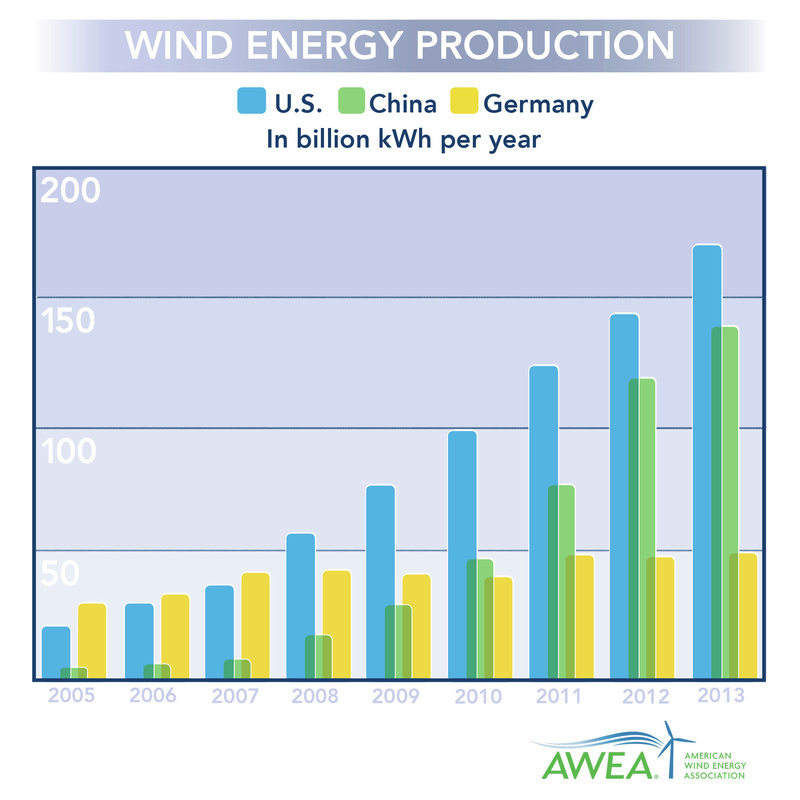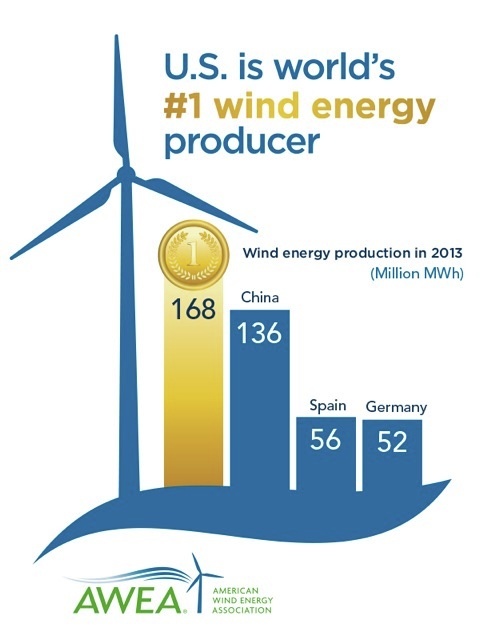News Release from American Clean Power Association (ACP)
Wind Industry Profile of
AWEA Blog - A pleasant surprise: USA, not China, is #1 in wind energy
The United States has more wind energy powering its grid than any other country in the world. Some mistakenly believe that China has become the leading producer of wind energy, surpassing the U.S. in this sector like so many others. It is true that China has more megawatts (MW) of wind turbines installed than the U.S. -- over 90,000 MW to just over 60,000 MW for the US. However, a better measure is the total amount of electricity, measured in kilowatt-hours (kWh), that each country produces from wind and delivers to customers each year. Capacity (MW) measures wind turbine production and installation, but it is the electrical energy (kWh) delivered to the grid that powers our factories, businesses and homes.
According to recent reports by the International Energy Agency and the Global Wind Energy Council, China’s wind industry produced and delivered less than 138 billion kWh in 2013. According to the American Wind Energy Association and the U.S. Department of Energy’s Energy Information Administration, the United States produced over 167 billion kWh, over 20 percent more than China. This confirms what many in the wind industry have thought for some time: that by the important measure of energy delivered to the grid, the United States is the # 1 wind energy producer in the world. Indeed, as the chart below shows, the U.S. has been the world leader by this measure since 2008.

There are a number of countries that get an even larger percentage of their electricity from wind – another important metric. However, annual production is a good indicator of how efficient and productive the U.S. wind industry is by world standards.
Why are we #1? The U.S. has been blessed with outstanding wind resources, both on land and offshore. We have also been able to use the best wind turbine technology, with over half the value of U.S. wind farms now “made in the USA.” Project developers, while not infallible, have made special efforts to choose project sites to avoid and minimize wildlife and other environmental impacts. Projects cannot be financed without an assurance of access to transmission interconnections to deliver their output to market. These and other factors have meant that the over $120 billion worth of U.S. wind projects installed since the year 2000 are of high overall quality and reliability, ready to operate on average more than 95 percent of the time the wind is strong enough to generate power.
Another key factor in the success of the U.S. wind industry has been that the government incentives and private sector financing methods used here reward long term production, not initial capital investment. The main government support mechanism, the federal renewable energy Production Tax Credit (PTC), is only earned for kilowatt hours actually produced and delivered during a ten year period. Back in the 1980s, developers could make a profit just by completing the projects, even if they never operated up to par. These incentives ended and were replaced in 1992 by the PTC, sponsored by Senator Grassley (R-IA) and extended on a bipartisan basis for over two decades. This performance-based policy has led to dramatic increases in the electricity output from individual turbines -- turbines today have a nameplate capacity 8 times larger than a typical one in 1990, generating 17 times more electricity.

Unfortunately, Congress allowed the PTC to expire at the end of 2013, resulting in a 92 percent reduction in new wind farm installations in 2013 compared to 2012. Congress can and should pass an extension of the PTC to help regain and maintain our momentum. In the next session the new Congress should enact stable long term energy policies that will help grow the industry even more efficiently and effectively.
Wind is one of the biggest, cheapest, and fastest ways to reduce emissions of carbon dioxide and other harmful air pollutants, and simultaneously uses no water. Indeed the financial advisory firm Lazard recently estimated that wind energy is more affordable than new natural gas or coal generation even without subsidies. It will play a key role in meeting any climate change programs we may pursue, including the upcoming implementation of the Environmental Protection Agency’s rules on carbon emissions from existing power plants. This adds credibility and bargaining strength for the United States in the upcoming climate negotiations to be held in Paris in 2015. Meeting the challenge of climate change makes wind energy part of a critical international “must win, must win” game in which we are all at risk and can all be winners.
We should be proud that we have (finally) joined the top ranks of wind producers but recognize that, as Charlie Brown said, “There is no heavier burden than a great potential!” The U.S. Department of Energy is working on a major “Wind Vision” study to be released next year that will provide just such a roadmap for how the industry can grow to supply 35 percent of U.S. electricity by 2050, making it one of the leading sources, if not the leading source, of electrical energy.
Wind energy is an American success story, and with the help of stable policies, it can be one of the great American success stories of the 21st Century.
To receive more information on this article, our Newsletter or find out more about what w3.windfair.net has to offer, please, do not hesitate to contact Trevor Sievert at ts@windfair.net.
Please don't forget to follow us on Twitter: w3.windfair.net on Twitter
w3.windfair.net is the largest international B2B internet platform in wind energy – ultimately designed for connecting wind energy enthusiasts and companies across the globe.
- Source:
- American Wind Energy Association
- Author:
- Edited by Trevor Sievert, Online Editorial Journalist / by AWEA Staff / James Walker
- Email:
- windmail@awea.org
- Link:
- www.aweablog.org/...

